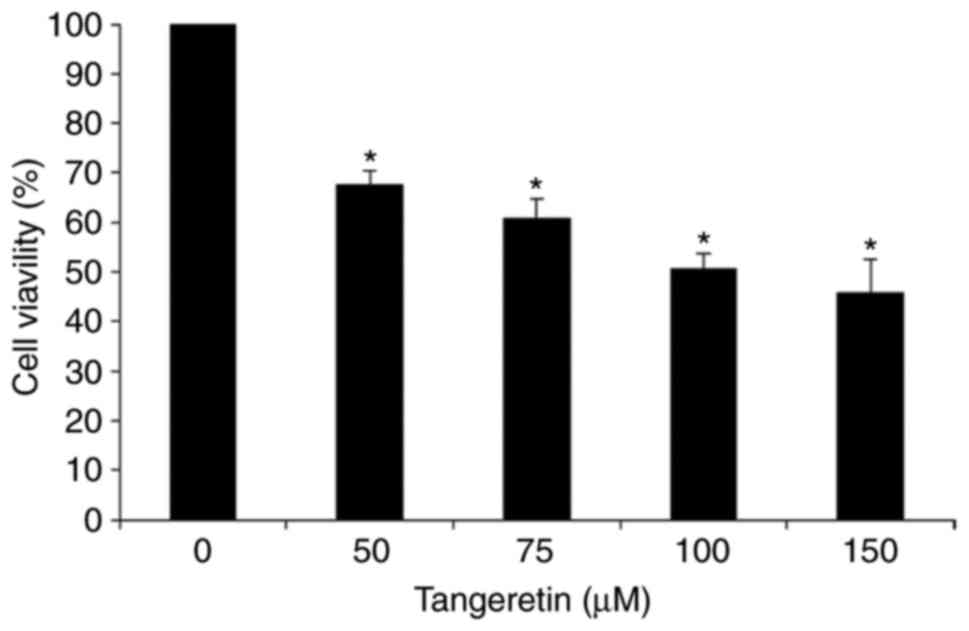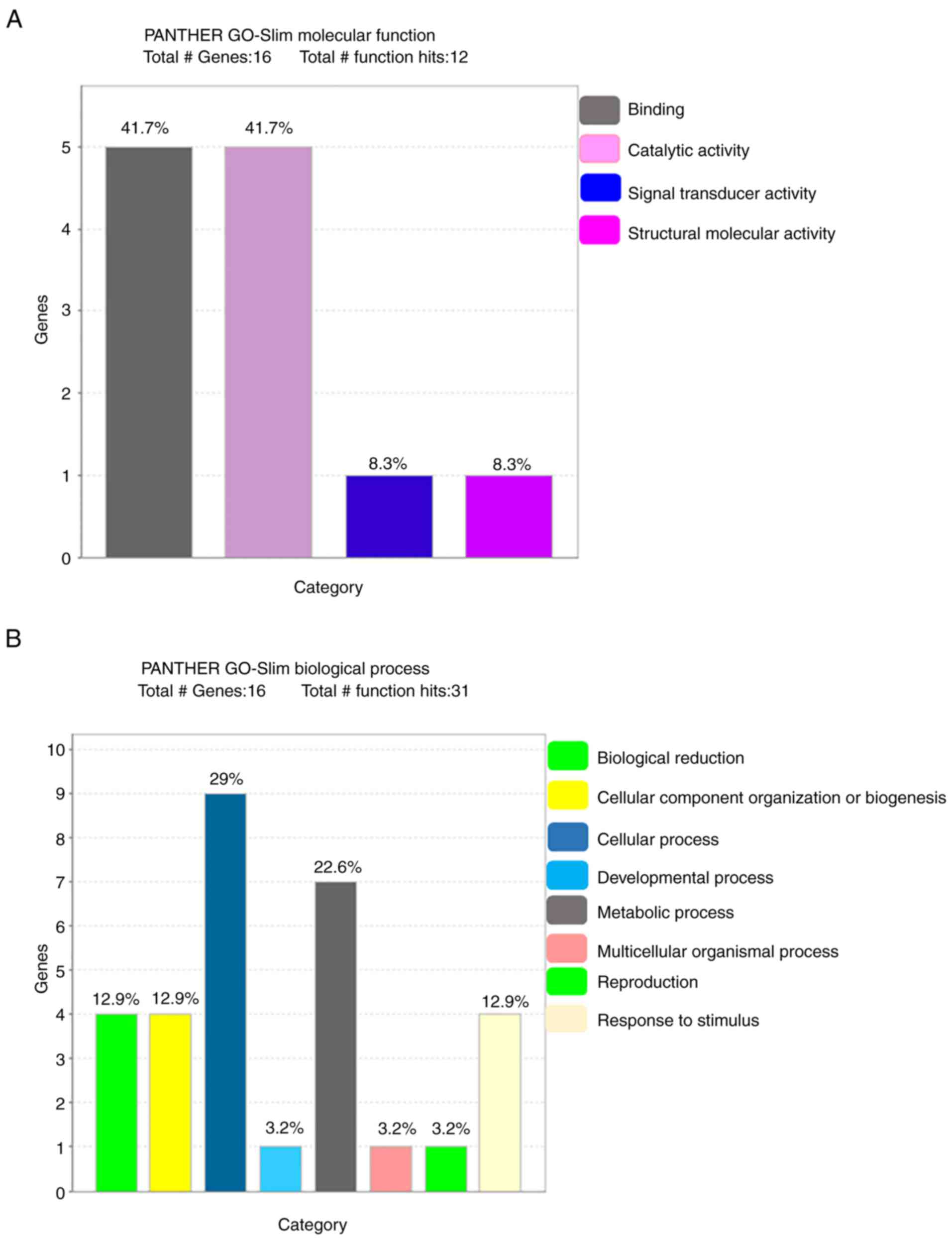|
1
|
Nagini S: Carcinoma of the stomach: A
review of epidemiology, pathogenesis, molecular genetics and
chemoprevention. World J Gastrointest Oncol. 4:156–169. 2012.
View Article : Google Scholar : PubMed/NCBI
|
|
2
|
Luo C, Du Z, Wei X, Chen G and Fu Z:
Bisdemethoxycurcumin attenuates gastric adenocarcinoma growth by
inducing mitochondrial dysfunction. Oncol Lett. 9:270–274. 2015.
View Article : Google Scholar : PubMed/NCBI
|
|
3
|
Ishii K, Tanaka S, Kagami K, Henmi K,
Toyoda H, Kaise T and Hirano T: Effects of naturally occurring
polymethyoxyflavonoids on cell growth, p-glycoprotein function,
cell cycle, and apoptosis of daunorubicin-resistant T
lymphoblastoid leukemia cells. Cancer Invest. 28:220–229. 2010.
View Article : Google Scholar : PubMed/NCBI
|
|
4
|
Manthey JA and Guthrie N:
Antiproliferative activities of citrus flavonoids against six human
cancer cell lines. J Agric Food Chem. 50:5837–5843. 2002.
View Article : Google Scholar : PubMed/NCBI
|
|
5
|
Conesa Martinez C, Ortega Vicente V,
Gascón Yáñez MJ, Baños Alcaraz M, Canteras Jordana M,
Benavente-García O and Castillo J: Treatment of metastatic melanoma
B16F10 by the flavonoids tangeretin, rutin, and diosmin. J Agric
Food Chem. 53:6791–6797. 2005. View Article : Google Scholar : PubMed/NCBI
|
|
6
|
Morley KL, Ferguson PJ and Koropatnick J:
Tangeretin and nobiletin induce G1 cell cycle arrest but not
apoptosis in human breast and colon cancer cells. Cancer Lett.
251:168–178. 2007. View Article : Google Scholar : PubMed/NCBI
|
|
7
|
Pan MH, Chen WJ, Lin-Shiau SY, Ho CT and
Lin JK: Tangeretin induces cell-cycle G1 arrest through inhibiting
cyclin-dependent kinases 2 and 4 activities as well as elevating
Cdk inhibitors p21 and p27 in human colorectal carcinoma cells.
Carcinogenesis. 23:1677–1684. 2002. View Article : Google Scholar : PubMed/NCBI
|
|
8
|
Dong Y, Cao A, Shi J, Yin P, Wang L, Ji G,
Xie J and Wu D: Tangeretin, a citrus polymethoxyflavonoid, induces
apoptosis of human gastric cancer AGS cells through extrinsic and
intrinsic signaling pathways. Oncol Rep. 31:1788–1794. 2014.
View Article : Google Scholar : PubMed/NCBI
|
|
9
|
Hong ML, Jiang N, Gopinath S and Chew FT:
Proteomics technology and therapeutics. Clin Exp Pharmacol Physiol.
33:563–568. 2006. View Article : Google Scholar : PubMed/NCBI
|
|
10
|
Grover A, Shandilya A, Bisaria VS and
Sundar D: Probing the anticancer mechanism of prospective herbal
drug Withaferin A on mammals: A case study on human and bovine
proteasomes. BMC Genomics. 11 Suppl 4:S152010. View Article : Google Scholar : PubMed/NCBI
|
|
11
|
Lu Z, Song Q, Yang J, Zhao X, Zhang X,
Yang P and Kang J: Comparative proteomic analysis of anti-cancer
mechanism by periplocin treatment in lung cancer cells. Cell
Physiol Biochem. 33:859–868. 2014. View Article : Google Scholar : PubMed/NCBI
|
|
12
|
Shevchenko A, Wilm M, Vorm O and Mann M:
Mass spectrometric sequencing of proteins silver-stained
polyacrylamide gels. Anal Chem. 68:850–858. 1996. View Article : Google Scholar : PubMed/NCBI
|
|
13
|
Szklarczyk D, Franceschini A, Kuhn M,
Simonovic M, Roth A, Minguez P, Doerks T, Stark M, Muller J, Bork
P, et al: The STRING database in 2011: Functional interaction
networks of proteins, globally integrated and scored. Nucleic Acids
Res. 39:D561–D568. 2011. View Article : Google Scholar : PubMed/NCBI
|
|
14
|
Sangwan V and Park M: Receptor tyrosine
kinases: Role in cancer progression. Curr Oncol. 13:191–193.
2006.PubMed/NCBI
|
|
15
|
Hall A: The cytoskeleton and cancer.
Cancer Metastasis Rev. 28:5–14. 2009. View Article : Google Scholar : PubMed/NCBI
|
|
16
|
Takai Y, Sasaki T and Matozaki T: Small
GTP-binding proteins. Physiol Rev. 81:153–208. 2001. View Article : Google Scholar : PubMed/NCBI
|
|
17
|
Yu Y and Feng YM: The role of kinesin
family proteins in tumorigenesis and progression: Potential
biomarkers and molecular targets for cancer therapy. Cancer.
116:5150–5160. 2010. View Article : Google Scholar : PubMed/NCBI
|
|
18
|
Paul MK and Mukhopadhyay AK: Tyrosine
kinase-Role and significance in cancer. Int J Med Sci. 1:101–115.
2004. View Article : Google Scholar : PubMed/NCBI
|
|
19
|
Berchtold MW and Villalobo A: The many
faces of calmodulin in cell proliferation, programmed cell death,
autophagy, and cancer. Biochim Biophys Acta. 1843:398–435. 2014.
View Article : Google Scholar : PubMed/NCBI
|
|
20
|
Miao Z, Ali A, Hu L, Zhao F, Yin C, Chen
C, Yang T and Qian A: Microtubule actin cross-linking factor 1, a
novel potential target in cancer. Cancer Sci. 108:1953–1958. 2017.
View Article : Google Scholar : PubMed/NCBI
|
|
21
|
Wang G, Tang J, Zhan W, Zhang R, Zhang M,
Liao D, Wang X, Wu Y and Kang T: CBX8 suppresses tumor metastasis
via repressing snail in esophageal squamous cell carcinoma.
Theranostics. 7:3478–3488. 2017. View Article : Google Scholar : PubMed/NCBI
|
|
22
|
de Resende MF, Vieira S, Chinen LT,
Chiappelli F, da Fonseca FP, Guimarães GC, Soares FA, Neves I,
Pagotty S, Pellionisz PA, et al: Prognostication of prostate cancer
based on TOP2A protein and gene assessment: TOP2A in prostate
cancer. J Transl Med. 11:362013. View Article : Google Scholar : PubMed/NCBI
|
|
23
|
Byun S, Lee KW, Jung SK, Lee EJ, Hwang MK,
Lim SH, Bode AM, Lee HJ and Dong Z: Luteolin inhibits protein
kinase C(epsilon) and c-Src activities and UVB-induced skin cancer.
Cancer Res. 70:2415–2423. 2010. View Article : Google Scholar : PubMed/NCBI
|
|
24
|
Pal D, Outram SP and Basu A: Upregulation
of PKCη by PKCε and PDK1 involves two distinct mechanisms and
promotes breast cancer cell survival. Biochim Biophys Acta.
1830:4040–4045. 2013. View Article : Google Scholar : PubMed/NCBI
|
|
25
|
Pan Q, Bao LW, Kleer CG, Sabel MS,
Griffith KA, Teknos TN and Merajver SD: Protein kinase C epsilon is
a predictive biomarker of aggressive breast cancer and a validated
target for RNA interference anticancer therapy. Cancer Res.
65:8366–8371. 2005. View Article : Google Scholar : PubMed/NCBI
|
|
26
|
Selzer E, Okamoto I, Lucas T, Kodym R,
Pehamberger H and Jansen B: Protein kinase C isoforms in normal and
transformed cells of the melanocytic lineage. Melanoma Res.
12:201–209. 2002. View Article : Google Scholar : PubMed/NCBI
|
|
27
|
Gutcher I, Webb PR and Anderson NG: The
isoform-specific regulation of apoptosis by protein kinase C. Cell
Mol Life Sci. 60:1061–1070. 2003. View Article : Google Scholar : PubMed/NCBI
|
|
28
|
Kampfer S, Windegger M, Hochholdinger F,
Schwaiger W, Pestell RG, Baier G, Grunicke HH and Uberall F:
Protein kinase C isoforms involved in the transcriptional
activation of cyclin D1 by transforming Ha-Ras. J Biol Chem.
276:42834–42842. 2001. View Article : Google Scholar : PubMed/NCBI
|
|
29
|
Ding L, Wang H, Lang W and Xiao L: Protein
kinase C-epsilon promotes survival of lung cancer cells by
suppressing apoptosis through dysregulation of the mitochondrial
caspase pathway. J Biol Chem. 277:35305–35313. 2002. View Article : Google Scholar : PubMed/NCBI
|
|
30
|
McJilton MA, Van Sikes C, Wescott GG, Wu
D, Foreman TL, Gregory CW, Weidner DA, Ford Harris O, Lasater
Morgan A, Mohler JL, et al: Protein kinase Cepsilon interacts with
Bax and promotes survival of human prostate cancer cells. Oncogene.
22:7958–7968. 2003. View Article : Google Scholar : PubMed/NCBI
|
|
31
|
Wu D, Foreman TL, Gregory CW, McJilton MA,
Wescott GG, Ford OH, Alvey RF, Mohler JL and Terrian DM: Protein
kinase cepsilon has the potential to advance the recurrence of
human prostate cancer. Cancer Res. 62:2423–2429. 2002.PubMed/NCBI
|
|
32
|
Cho SH, Ahn AK, Bhargava P, Lee CH,
Eischen CM, McGuinness O and Boothby M: Glycolytic rate and
lymphomagenesis depend on PARP14, an ADP ribosyltransferase of the
B aggressive lymphoma (BAL) family. Proc Natl Acad Sci USA.
108:15972–15977. 2011. View Article : Google Scholar : PubMed/NCBI
|
|
33
|
Iansante V, Choy PM, Fung SW, Liu Y, Chai
JG, Dyson J, Del Rio A, D'Santos C, Williams R, Chokshi S, et al:
PARP14 promotes the Warburg effect in hepatocellular carcinoma by
inhibiting JNK1-dependent PKM2 phosphorylation and activation. Nat
Commun. 6:78822015. View Article : Google Scholar : PubMed/NCBI
|
|
34
|
Barbarulo A, Iansante V, Chaidos A, Naresh
K, Rahemtulla A, Franzoso G, Karadimitris A, Haskard DO, Papa S and
Bubici C: Poly(ADP-ribose) polymerase family member 14 (PARP14) is
a novel effector of the JNK2-dependent pro-survival signal in
multiple myeloma. Oncogene. 32:4231–4242. 2013. View Article : Google Scholar : PubMed/NCBI
|
|
35
|
Aberg E, Perander M, Johansen B, Julien C,
Meloche S, Keyse SM and Seternes OM: Regulation of MAPK-activated
protein kinase 5 activity and subcellular localization by the
atypical MAPK ERK4/MAPK4. J Biol Chem. 281:35499–35510. 2006.
View Article : Google Scholar : PubMed/NCBI
|
|
36
|
Perander M, Al-Mahdi R, Jensen TC, Nunn
JA, Kildalsen H, Johansen B, Gabrielsen M, Keyse SM and Seternes
OM: Regulation of atypical MAP kinases ERK3 and ERK4 by the
phosphatase DUSP2. Sci Rep. 7:434712017. View Article : Google Scholar : PubMed/NCBI
|
|
37
|
Stöhr N, Köhn M, Lederer M, Glass M,
Reinke C, Singer RH and Hüttelmaier S: IGF2BP1 promotes cell
migration by regulating MK5 and PTEN signaling. Genes Dev.
26:176–189. 2012. View Article : Google Scholar : PubMed/NCBI
|
|
38
|
Balla A and Balla T: Phosphatidylinositol
4-kinases: Old enzymes with emerging functions. Trends Cell Biol.
16:351–361. 2006. View Article : Google Scholar : PubMed/NCBI
|
|
39
|
Chu KM, Minogue S, Hsuan JJ and Waugh MG:
Differential effects of the phosphatidylinositol 4-kinases, PI4KIIα
and PI4KIIIβ, on Akt activation and apoptosis. Cell Death Dis.
1:e1062010. View Article : Google Scholar : PubMed/NCBI
|
|
40
|
Waugh MG: Phosphatidylinositol 4-kinases,
phosphatidylinositol 4-phosphate and cancer. Cancer Lett.
325:125–131. 2012. View Article : Google Scholar : PubMed/NCBI
|
















